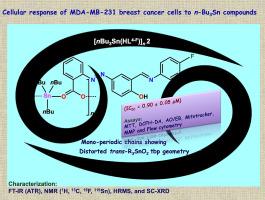亚甲亚胺和二氮基功能化苯甲酯与外周氟配合物对MDA-MB-231乳腺癌细胞的合成及抗癌评价
IF 3.2
2区 化学
Q2 BIOCHEMISTRY & MOLECULAR BIOLOGY
引用次数: 0
摘要
通过与(n-Bu3Sn)2O反应,合成了[n-Bu3Sn(HLH)](1)、[n-Bu3Sn(HL4-F)](2)、[n-Bu3Sn(HL2-CF3)](3)、[n-Bu3Sn(HL3-CF3)](4)和[n-Bu3Sn(HL4-CF3)](5)五个配合物,分别为偶亚甲基化和二氮基化羟基苯甲酸前配体(H'HLH、H'HL4-F、H'HL2-CF3、H'HL3-CF3和H'HL4-CF3)。化合物1 ~ 5通过FT-IR和NMR (1H, 13C和119Sn)光谱进行了彻底的表征。此外,通过单晶x射线衍射分析确定了化合物2、4和5及其一个前配体(H'HL3-CF3)的分子和晶体结构。三丁基锡(IV)配合物(2,4和5)形成单周期链,其中n-Bu3Sn基团通过一个短和一个长Sn-O键与苯甲酸酯配体的氧原子相连。这种排列导致五配位锡中心,显示出轻微扭曲的反式bu3sno2三角-双锥体几何形状,如它们的τ5参数所示。羟基H原子与亚胺N原子形成分子内O-H··N氢键,如H'HL3-CF3晶体结构所示。化合物1 ~ 5的119Sn核磁共振谱在+110 ppm左右出现共振,符合溶液中的四面体几何形状。这表明,在固体状态下观察到的配合物2、4和5的聚合物结构在溶解时解离。研究了三正丁基化合物1-5对MDA-MB-231乳腺癌细胞的体外细胞毒性。化合物1 ~ 5对MDA-MB-231细胞具有较强的细胞毒性(IC50: 0.90 ~ 2.18 μM),其中含氟配合物[n-Bu3Sn(HL4-F)](2)的IC50 = 0.90±0.05 μM)活性最强。根据各种生物试验的结果,讨论了所提出的作用机制。本文章由计算机程序翻译,如有差异,请以英文原文为准。

Synthesis and anticancer evaluation of tri-n-butyltin complexes featuring azomethine- and diazenyl-functionalized benzoates with peripheral fluorine against MDA-MB-231 breast cancer cells
Five complexes, [n-Bu3Sn(HLH)] (1), [n-Bu3Sn(HL4-F)] (2), [n-Bu3Sn(HL2-CF3)] (3), [n-Bu3Sn(HL3-CF3)] (4) and [n-Bu3Sn(HL4-CF3)] (5), were synthesized by reacting the corresponding azomethine- and diazenyl-functionalized hydroxy-benzoic acid pro-ligands (H'HLH, H'HL4-F, H'HL2-CF3, H'HL3-CF3 and H'HL4-CF3) with (n-Bu3Sn)2O. Compounds 1–5 were thoroughly characterized by FT-IR and NMR (1H, 13C, and 119Sn) spectroscopy. Additionally, the molecular and crystal structures of compounds 2, 4 and 5, along with one of their pro-ligands (H'HL3-CF3), were determined by single-crystal X-ray diffraction analysis. The tri-n-butyltin(IV) complexes (2, 4, and 5) form mono-periodic chains in which the n-Bu3Sn groups are linked to the oxygen atoms of the benzoate ligand through one short and one long Sn-O bond. This arrangement results in a pentacoordinated tin center, exhibiting slightly distorted trans-Bu3SnO2 trigonal-bipyramidal geometries, as indicated by their τ5 parameters. The hydroxy H atom forms an intramolecular O–H···N hydrogen bond with the imine N-atom, as observed in the crystal structure of H'HL3-CF3. The 119Sn NMR spectra of compounds 1–5 showed a resonance at around +110 ppm, consistent with a tetrahedral geometry in solution. This suggests that the polymeric structures of complexes 2, 4, and 5 observed in the solid state dissociate upon dissolution. The in vitro cytotoxicity of the tri-n-butyl compounds 1–5 was assessed against MDA-MB-231 breast cancer cells. Compounds 1–5 showed potent cytotoxicity against MDA-MB-231 cells (IC50: 0.90–2.18 μM), with the fluorinated complex [n-Bu3Sn(HL4-F)] (2) being the most active (IC50 = 0.90 ± 0.05 μM). The proposed mechanism of action is discussed in light of findings from various biological assays.
求助全文
通过发布文献求助,成功后即可免费获取论文全文。
去求助
来源期刊

Journal of Inorganic Biochemistry
生物-生化与分子生物学
CiteScore
7.00
自引率
10.30%
发文量
336
审稿时长
41 days
期刊介绍:
The Journal of Inorganic Biochemistry is an established international forum for research in all aspects of Biological Inorganic Chemistry. Original papers of a high scientific level are published in the form of Articles (full length papers), Short Communications, Focused Reviews and Bioinorganic Methods. Topics include: the chemistry, structure and function of metalloenzymes; the interaction of inorganic ions and molecules with proteins and nucleic acids; the synthesis and properties of coordination complexes of biological interest including both structural and functional model systems; the function of metal- containing systems in the regulation of gene expression; the role of metals in medicine; the application of spectroscopic methods to determine the structure of metallobiomolecules; the preparation and characterization of metal-based biomaterials; and related systems. The emphasis of the Journal is on the structure and mechanism of action of metallobiomolecules.
 求助内容:
求助内容: 应助结果提醒方式:
应助结果提醒方式:


